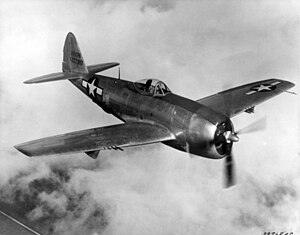F-47 Thunderbolt
| P-47 Thunderbolt | |
|---|---|
 |
|
| P-47N flying over the Pacific during World War II | |
| Role | Fighter-bomber |
| Manufacturer | Republic Aviation |
| Designer | Alexander Kartveli |
| First flight | 6 May 1941 |
| Introduction | November 1942 |
| Retired | 1966, Peruvian Air Force |
| Primary users |
United States Army Air Forces Royal Air Force French Air Force |
| Produced | 1941–1945 |
| Number built | 15,636 |
| Unit cost |
US$ 83,000 in 1945
|
| Variants | Republic XP-72 |
The Republic P-47 Thunderbolt was a World War II era fighter aircraft produced by the United States between 1941 and 1945. Its primary armament was eight .50-caliber machine guns and in the fighter-bomber ground-attack role it could carry five-inch rockets or a bomb load of 2,500 pounds (1,103 kg). When fully loaded the P-47 weighed up to eight tons (tonnes) making it one of the heaviest fighters of the war. The P-47 was designed around the powerful Pratt & Whitney R-2800 Double Wasp engine which was also used by two U.S. Navy fighters, the Grumman F6F Hellcat and the Vought F4U Corsair. The Thunderbolt was effective as a short-to-medium range escort fighter in high-altitude air-to-air combat and ground attack in both the World War II European and Pacific theaters.
The P-47 was one of the main United States Army Air Forces (USAAF) fighters of World War II, and served with Allied air forces including France, Britain, and Russia. Mexican and Brazilian squadrons fighting alongside the U.S. were equipped with the P-47.
The armored cockpit was relatively roomy and comfortable, offering good visibility. A modern-day U.S. ground-attack aircraft, the Fairchild Republic A-10 Thunderbolt II, takes its name from the P-47.
The P-47 Thunderbolt was a design of Georgian immigrant Alexander Kartveli, and was to replace the Seversky P-35 that was developed earlier by Russian immigrant Alexander P. de Seversky. Both had fled from their homeland to escape the Bolsheviks.
...
Wikipedia
